Metamorphic Evolution of Garnet-Bearing Ultramafic Rocks in the Hujialin Area, Sulu Ultrahigh-Pressure Orogenic Belt, Eastern China
Abstract
1. Introduction
2. Geological Setting
3. Analytical Methods
4. Petrography and Mineral Chemistry
5. Whole-Rock Geochemistry
5.1. Major Elements
5.2. Trace Elements
6. U–Pb Geochronology
7. Discussion
7.1. Metamorphic Evolution
7.2. Protolith and Structural Model
8. Conclusions
Supplementary Materials
Author Contributions
Funding
Acknowledgments
Conflicts of Interest
References
- Chopin, C. Coesite and pure pyrope in high-grade blueschists of the Western Alps: A first record and some consequences. Contrib. Mineral. Petrol. 1984, 86, 107–118. [Google Scholar] [CrossRef]
- Smith, D.C. Coesite in clinopyroxene in the Caledonides and its implications for geodynamics. Nature 1984, 310, 641–644. [Google Scholar] [CrossRef]
- Sobolev, N.V.; Shatsky, V.S. Diamond inclusions in garnets from metamorphic rocks-a new environment for diamond formation. Nature 1990, 343, 7427–7446. [Google Scholar] [CrossRef]
- Yang, J.J.; Godard, G.; Kienast, J.R.; Lu, Y.Z.; Sun, J.X. Ultrahigh-pressure (60 kbar) magnesite-bearing garnet peridotites from Northeastern Jiangsu, China. J. Geol. 1993, 101, 541–554. [Google Scholar] [CrossRef]
- Yang, J.J.; Zhu, H.; Deng, J.F.; Zhou, T.Z.; Lai, S.C. Discovery of garnet peridotite atthe northern margin of the Qaidam Basin and its significance. Acta Petrol. Mineral. 1994, 13, 97–105. [Google Scholar]
- Dobrzhinetskaya, L.F.; Eide, E.A.; Larsen, R.B.; Sturt, B.A.; Tronnes, R.G.; Smith, D.C.; Posukhova, T.V. Microdiamond in high-grade metamorphic rocks of the Western Gneiss Region, Norway. Geology 1995, 23, 597–600. [Google Scholar] [CrossRef]
- Van Roermund, H.L.M.; Drury, M.R. Ultra-high pressure (P > 6 GPa) garnet peridotites in Western Norway: Exhumation of mantle rocks from >185 km depth. Terra Nova 1998, 10, 295–301. [Google Scholar] [CrossRef]
- Zhang, R.Y.; Liou, J.G.; Yang, J.S.; Yui, T.F. Petrochemical constraints for dualorigin of garnet peridotites from the Dabie-Sulu UHP terrane, eastern-central China. J. Metamorph. Geol. 2000, 18, 149–166. [Google Scholar] [CrossRef]
- Song, S.G.; Zhang, L.F.; Niu, Y.L. Ultra-deep origin of garnet peridotite from theNorth Qaidam ultrahigh-pressure belt, Northern Tibetan Plateau, NW China. Am. Mineral. 2004, 89, 1330–1336. [Google Scholar] [CrossRef]
- Zhang, C.; van Roermund, H.; Zhang, L.F. Orogenic garnet peridotites: Tools to reconstruct Paleo-Geodynamic settings of fossil continental collision zones. Ultrah. Press. Metamorph. 2011, 513–551. [Google Scholar] [CrossRef]
- Pearson, D.G.; Davies, G.R.; Nixon, P.H. Geochemical constrains on the petrogenesis of Diamond Facies Pyroxenites from the Beni Bousera Peridotite Massif, North Morocco. J. Petrol. 1993, 34, 125–172. [Google Scholar] [CrossRef]
- Li, X.-P.; Yan, J.-Y.; Schertl, H.-P.; Kong, F.-M.; Xu, H. Eclogite from the Qianliyan Island in the Yellow Sea: A missing link between the mainland of China and the Korean peninsula. Eur. J. Mineral. 2014, 26, 727–741. [Google Scholar] [CrossRef]
- Pilitsyna, A.V.; Tretyakov, A.A.; Degtyarev, K.E.; Cuthbert, S.J.; Batanova, V.G.; Kovalchuk, E.V. Eclogites and garnet clinopyroxenites in the Anrakhai complex, Central Asian Orogenic Belt, Southern Kazakhstan: P-T evolution, protoliths and some geodynamic implications. J. Asian Earth Sci. 2018, 153, 325–345. [Google Scholar] [CrossRef]
- Zhang, C.; Bader, T.; Zhang, L.M.; Shen, T.T.; Li, P.; Li, X.-P. Metamorphic evolution and age constraints of the garnet-bearing mica schist from the Xindaduo area of the Sumdo (U) HP metamorphic belt, Tibet. Geol. Mag. 2019, 156, 1175–1189. [Google Scholar] [CrossRef]
- Li, X.-P.; Chen, H.-K.; Wang, Z.-L.; Wang, L.-J.; Yang, J.-S.; Robinson, P. Textural evolution of spinel peridotite and olivine websterite in the Purang ophiolite complex, western Tibet. J. Asian Earth Sci. 2015, 110, 55–71. [Google Scholar] [CrossRef]
- Ishikawa, A.; Maruyama, S.; Komiya, T. Layered lithospheric mantle beneath the Ontong Java Plateau: Implications from xenoliths in Alnoite, Malaita, SolomonIslands. J. Petrol. 2004, 45, 2011–2044. [Google Scholar] [CrossRef]
- Xiong, F.; Meng, Y.; Yang, J.; Liu, Z.; Xu, X.; Eslami, A.; Zhang, R. Geochronology and petrogenesis of the mafic dykes from the Purang ophiolite: Implications for evolution of the western Yarlung-Tsangpo suture zone, Tibet. Geosci. Front. 2019, 11, 277–292. [Google Scholar] [CrossRef]
- Zhang, R.Y.; Liou, J.G. Clinopyroxenite from the Sulu ultrahigh-pressure terrane, eastern China: Origin and evolution of garnet exsolution in clinopyroxene. Am. Mineral. 2003, 88, 1591–1600. [Google Scholar] [CrossRef]
- Xu, Z.Q.; Zeng, L.S.; Liu, F.; Yang, J.S.; Zhang, Z.M.; McWilliams, M.; Liou, J.G. Polyphase subduction and exhumation of the Sulu high-pressure–ultrahigh-pressure metamorphic terrane. In Ultrahigh-Pressure Metamorphism: Deep Continental Subduction; Special Paper 403; Geological Society of America: Boulder, CO, USA, 2006; pp. 93–113. [Google Scholar] [CrossRef]
- Wang, S.J.; Li, X.P.; Schertl, H.P.; Feng, Q.D. Petrogenesis of early cretaceous andesite dykes in the Sulu orogenic belt, eastern China. Mineral. Petrol. 2019, 113, 77–97. [Google Scholar] [CrossRef]
- Liu, F.L.; Xu, Z.Q.; Yang, J.S.; Zhang, Z.M.; Xue, H.M.; Li, T.F. Geochemical characteristics and UHP metamorphism of granitic gneisses in the maindrilling hole of Chinese Continental Scientific Drilling Project and its adjacent area. Acta Petrol. Sin. 2004, 20, 9–26. [Google Scholar]
- Hiramatsu, N.; Hirajima, T. Petrology of the Hujialin garnet clinopyroxenite in the Su-Lu ultrahigh-pressure province, eastern China. Island Arc. 1995, 4, 310–323. [Google Scholar] [CrossRef]
- Chen, J.; Xu, Z. Pargasite and ilmenite exsolution texture in clinopyroxenes from the Hujialing garnet-pyroxenite, Su-lu UHP terrane, central China: A geodynamic implication. Eur. J. Mineral. 2005, 17, 895–903. [Google Scholar] [CrossRef]
- Zhang, R.Y.; Zhai, S.M.; Fei, Y.W.; Liou, J.G. Titanium solubility in coexistinggarnet and clinopyroxene at very high pressure: The significance of exsolved rutile ingarnet. Earth Planet. Sci. Lett. 2003, 216, 591–601. [Google Scholar] [CrossRef]
- Zhang, R.Y.; Liou, J.G.; Huberty, J.M.; Xu, H.; Maki, K.; Jahn, B.-M.; Iizuka, Y. Origin and Metamorphic Evolution of Garnet Clinopyroxenite from the Sulu UHP Terrane, China. Ultrah. Press. Metamorph. 2011, 151–185. [Google Scholar] [CrossRef]
- Yang, J.-J. Ca-rich garnet clinopyroxenite rocks at Hujialin in the SuLu terrane (eastern China): Deeply subducted arc cumulates? J. Petrol. 2006, 47, 965–990. [Google Scholar] [CrossRef][Green Version]
- Li, T.F.; Yang, J.S.; Zhang, R.Y. Geochemical Characteristics, UHP Metamorphic Age, and Genesis of the Hujialing Garnet Clinopyroxenite, Sulu Terrane, China. Int. Geol. Rev. 2008, 50, 48–60. [Google Scholar] [CrossRef]
- Xie, Z.P.; Wang, J.; Hattori, K.; Xue, C.D.; Zhong, J.W.; Wang, Z.L. The petrogenesis and tectonic implication of Hujialin ultramafic rocks in the Sulu ultrahigh-pressure metamorphic belt, eastern China. Acta Petrol. Sin. 2018, 34, 1539–1556. (In Chinese) [Google Scholar]
- Zhao, R.X.; Liou, J.G.; Tsujimori, T.; Zhang, R.Y. Petrology and U-Pb SHRIMP geochronology of a garnet peridotite, Sulu UHP terrane, east-central China. Int. Geol. Rev. 2007, 49, 732–752. [Google Scholar] [CrossRef]
- Gao, T.S.; Chen, J.F.; Xie, Z. Petrology and Geochemistry of Ultramafic Rocks at Hujialin, Sulu Orogen. Bull. Mineral. Petrol. Geochem. 2015, 34, 601–618. (In Chinese) [Google Scholar]
- Zong, K.Q.; Klemd, R.; Yuan, Y.; He, Z.Y.; Guo, J.L.; Shi, X.L.; Liu, Y.S.; Hu, Z.C.; Zhang, Z.M. The assembly of Rodinia: The correlation of early Neoproterozoic (ca. 900 Ma) high-grade metamorphism and continental arc formation in the southern Beishan Orogen, southern central Asian Orogenic Belt (CAOB). Precambrian Res. 2017, 290, 32–48. [Google Scholar] [CrossRef]
- Liu, Y.S.; Hu, Z.C.; Gao, S.; Günther, D.; Xu, J.; Gao, C.G.; Chen, H.H. In situ analysis of major and trace elements of anhydrous minerals by LA-ICP-MS without applying an internal standard. Chem. Geol. 2008, 257, 34–43. [Google Scholar] [CrossRef]
- Ludwig, K. User’s manual for Isoplot 3.00: A geochronological toolkit for Microsoft Excel. Berkeley Geochronol. Cent. Spec. Publ. 2003, 1, 1–55. [Google Scholar]
- Whitney, D.L.; Evans, B.W. Abbreviations for names of rock-forming minerals. Am. Mineral. 2010, 95, 185–187. [Google Scholar] [CrossRef]
- Obata, M.; Morten, L. Transformation of spinel lherzolite to garnet lherzolite in ultramafic lenses of the Austridic Crystalline Complex, northern Italy. J. Petrol. 1987, 28, 599–623. [Google Scholar] [CrossRef]
- Staudigel, H.; Schreyer, W. The upper thermal stability of clinochlore, Mg5Al (AlSi3O10) (OH)8, at 10–35 kb PH2O. Contrib. Mineral. Petrol. 1977, 61, 187–198. [Google Scholar] [CrossRef]
- Schmidt, M.W.; Poli, S. Experimentally based water budgets for dehydrating slabs and consequences for arc magma generation. Earth Planet. Sci. Lett. 1998, 163, 361–379. [Google Scholar] [CrossRef]
- Ulmer, P.; Trommsdorff, V. Serpentine stability to mantledepths and subduction-related magmatism. Science 1995, 268, 858–861. [Google Scholar] [CrossRef]
- Alison, P. Chlorite stability in mantle peridotite: The reaction clinochlore + enstatite = forsterite + pyrope + H2O. Contrib. Mineral. Petrol. 2003, 144, 449–456. [Google Scholar]
- Yang, J.-J. Titanian clinohumite–garnet–pyroxene rock from the Su-Lu UHP metamorphic terrane, China: Chemical evolutionand tectonic implications. Lithos 2003, 70, 359–379. [Google Scholar] [CrossRef]
- Chen, Y.; Su, B.; Guo, S. The Dabie-Sulu orogenic peridotites: Progress and key issues. Sci. China Earth Sci. 2015, 58, 1679–1699. (In Chinese) [Google Scholar] [CrossRef]
- Yang, T.N.; Zeng, L.S.; Liou, J.G. Mineral evolutionof a garnet-pyroxenite nodule within eclogite, easternSulu ultrahigh-pressure metamorphic terrane, East China. J. Metamorph. Geol. 2005, 23, 667–680. [Google Scholar] [CrossRef]
- Zeng, L.S.; Yang, T.N. Rongcheng Ultra-Calcic Garnet Pyroxenite:Its Geochemistry, Origin and Implications for Pre-UHP Tectonics in the Sulu UHP Metamorphic Belt. Earth Sci. 2006, 31, 488–496. (In Chinese) [Google Scholar]
- McDonough, W.F.; Sun, S.S. The compositionof the Earth. Chem. Geol. 1995, 120, 223–254. [Google Scholar] [CrossRef]
- Geng, Y.S.; Kuang, H.W.; Du, L.L.; Liu, Y.Q.; Zhao, T.P. On the Paleo-Mesoproterozoic boundary from the breakup event of the Columbia supercontinent. Acta Petrol. Sin. 2019, 35, 2299–2324. [Google Scholar]
- Zheng, Y.F.; Wu, Y.B.; Zhao, Z.F.; Zhang, S.B.; Xu, P.; Wu, F.Y. Metamorphic effect on zircon Lu–Hf and U–Pb isotope systems in ultrahigh-pressure eclogite-facies metagranite and metabasite. Earth Planet. Sci. Lett. 2005, 240, 378–400. [Google Scholar] [CrossRef]
- Wang, S.J.; Schertl, H.P.; Pang, Y.M. Geochemistry, geochronology and Sr-Nd-Hf Isotopes of two types of Early Cretaceous granite porphyry dykes in the Sulu Orogenic Belt, Eastern China. Can. J. Earth Sci. 2020, 57, 249–266. [Google Scholar] [CrossRef]
- Zheng, Y.F. Fluid regime in continental subduction zones: Petrological insights from ultrahigh-pressure metamorphic rocks. J. Geol. Soc. 2009, 166, 763–782. [Google Scholar] [CrossRef]
- Yang, J.S.; Wooden, J.L.; Wu, C.L.; Liu, F.L.; Xu, Z.Q.; Shi, R.D.; Katayama, I.; Liou, J.G.; Maruyama, S. SHRIMP U-Pb dating of coesite-bearing zircon from the ultrahigh-pressure metamorphic rocks, Sulu terrane, east China. J. Metamorph. Geol. 2003, 21, 551–560. [Google Scholar] [CrossRef]
- Connolly, J.A.D. Multivariable phase-diagrams: An algorithm based on generalized thermodynamics. Am. J. Sci. 1990, 290, 666–718. [Google Scholar] [CrossRef]
- Connolly, J.A.D. Computation of phase equilibria by linear programming: A toolfor geodynamic modeling and its application to subduction zone decarbonation. Earth Planet. Sci. Lett. 2005, 236, 524–541. [Google Scholar] [CrossRef]
- Holland, T.J.B.; Powell, R. An internally consistent thermodynamic data set for phases of petrological interest. J. Metamorph. Geol. 1998, 16, 309–343. [Google Scholar] [CrossRef]
- White, R.W.; Powell, R.; Holland, T.J.B.; Worley, B.A. The effect of TiO2 and Fe2O3 on metapelitic assemblages at greenschist and amphibolite facies conditions: Mineralequilibria calculations in the system K2O-FeO-MgO-Al2O3- SiO2-H2O-TiO2-Fe2O3. J. Metamorph. Geol. 2000, 18, 497–511. [Google Scholar] [CrossRef]
- Holland, T.; Powell, R. Thermodynamics of order-disorder in minerals: II. Symmetric formalism applied to solid solutions. Am. Mineral. 1996, 81, 1425–1437. [Google Scholar] [CrossRef]
- Dale, J.; Holland, T.; Powell, R. Hornblende-garnet-plagioclase thermobarometry: A natural assemblage calibration of the thermodynamics of hornblende. Contrib. Mineral. Petrol. 2000, 140, 353–362. [Google Scholar] [CrossRef]
- White, R.W.; Powell, R.; Clarke, G.L. The interpretation of reaction textures in Fe-rich metapelitic granulites ofthe Musgrave Block, central Australia: Constraints from mineral equilibria calculations in the system K2O-FeO-MgO- Al2O3-SiO2-H2O-TiO2-Fe2O3. J. Metamorph. Geol. 2002, 20, 41–55. [Google Scholar] [CrossRef]
- Krogh Ravna, E.J. The garnet–clinopyroxene Fe2+–Mg geothermometer: An updated calibration. J. Metamorph. Geol. 2000, 18, 211–219. [Google Scholar] [CrossRef]
- Wang, S.J.; Wang, L.; Brown, M.; Feng, P.P. Multi-stage barite crystallization in partially melted UHP eclogite from the Sulu belt, China. Am. Mineral. 2016, 101, 564–579. [Google Scholar] [CrossRef]
- Wang, L.; Kusky, T.M.; Polat, A.; Wang, S.J.; Jiang, X.; Zong, K.; Wang, J.P.; Deng, H.; Fu, J. Partial melting of deeply subducted eclogite from the Sulu orogen in China. Nat. Commun. 2014, 5, 5604. [Google Scholar] [CrossRef]
- Schmidt, M.W. Amphibole composition in tonalite as a function of pressure: An experimental calibration of the Al-in-hornblende barometer. Contrib. Mineral. Petrol. 1992, 110, 304–310. [Google Scholar] [CrossRef]
- Jahn, B.M. Geochemical and Isotopic Characteristics of UHP Eclogites and Ultramafic Rocks of the Dabie Orogen: Implications for Continental Subduction and Collisional Tectonics. Petrol. Struct. Geol. 1998, 10, 203–239. [Google Scholar]
- Gonzaga, R.G.; Lowry, D.; Jacob, D.E.; LeRoex, A.; Schulze, D.; Menzies, M.A. Eclogites and garnet pyroxenites: Similarities and differences. J. Volcanol. Geotherm. Res. 2010, 190, 235–247. [Google Scholar] [CrossRef]
- Zhang, X.; Li, X.P.; Wang, Z.L.; Zhao, L.Q.; Shi, T.Q.; Duan, W.Y. Mineralogical and Petrogeochemical characteristics of the garnet amphibolites in the Xigaze ophiolite, Tibet. Acta Petrol. Sin. 2016, 32, 3685–3702. [Google Scholar]
- McCulloch, M.T.; Gamble, J.A. Geochemical and geodynamical constraints on subduction zone magmatism. Earth Planet. Sci. Lett. 1991, 102, 358–374. [Google Scholar] [CrossRef]
- Davidson, J.P. Deciphering mantle and crustal signatures in subduction zone magmatism. Geophys. Monogr. 1996, 96, 251–264. [Google Scholar]
- Wang, X.; Li, X.-P.; Han, Z.Z. Zircon ages and geochemistry of amphibolitic rocks from the Paleoproterozoic Erdaowa Group in the Khondalite Belt, North China Craton and their tectonic implications. Precambrian Res. 2018, 317, 253–267. [Google Scholar] [CrossRef]
- Wang, X.; Li, X.-P.; Zhang, J.; Schertl, H.-P. Geochemistry, geochronology and evolution of Paleoproterozoic granitoid gneisses in the Khondalite Belt, North China Craton. Precambrian Res. 2020, 338. [Google Scholar] [CrossRef]
- Zanetti, A.; Mazzucchelli, M.; Rivalenti, G.; Vannucci, R. TheFinero phlogopite-peridotite massif: An example of subductionrelated metasomatism. Contrib. Mineral. Petrol. 1999, 134, 107–122. [Google Scholar] [CrossRef]
- Brueckner, H.K.; Medaris, L.G. A general model for the intrusion and evolution of mantle garnet peridotites in high-pressure and ultra-high-pressure metamorphic terranes. J. Metamorph. Geol. 2000, 18, 123–133. [Google Scholar] [CrossRef]
- Li, X.-P.; Yang, J.-S.; Robinson, P.; Xu, Z.-Q.; Li, T.-F. Petrology and geochemistry of UHP-metamorphosed ultramafic–mafic rocks from the main hole of the Chinese Continental Scientific Drilling Project (CCSD-MH), China: Fluid/melt-rock interaction Mafic–ultramafic complex. J. Asian Earth Sci. 2011, 42, 661–683. [Google Scholar] [CrossRef]
- Paquin, J.; Altherr, R. Subduction-related lithium metasomatism during exhumation of the Alpe Arami ultrahigh-pressuregarnet peridotite (Central Alps, Switzerland). Contrib. Mineral. Petrol. 2002, 143, 623–640. [Google Scholar] [CrossRef]
- Li, X.-P.; Schertl, H.-P.; Reinhardt, J. Preface: Metamorphism and Orogenic Belts: Response from micro- to macro-scale. J. Earth Sci. 2019, 30, 1075–1083. [Google Scholar] [CrossRef]
- Sun, G.; Li, X.-P.; Dun, W.; Chen, S.; Wang, Z.; Zhao, L.; Fen, Q. Metamorphic Characteristics and Tectonic Implications of the Kadui Blueschist in the Central Yarlung Zangbo Suture Zone, Southern Tibet. J. Earth Sci. 2018, 29, 1026–1039. [Google Scholar] [CrossRef]
- Zhang, Y.-C.; Li, X.-P.; Sun, G.-M.; Wang, Z.-L.; Duan, W.-Y. Metamorphic petrology of clinopyroxene amphibolite from the Xigaze ophiolite, Southern Tibet: P-T constraints and phase equilibrium modeling. J. Earth Sci. 2019, 30, 549–562. [Google Scholar] [CrossRef]
- Kong, F.-M.; Liu, Y.; Li, X.-P.; Guo, J.H.; Zhao, G.C. Mineralogical and Petrogeochemical characteristics of ultramafic rocks from the metamorphic basement of the Jiaobei terrane. Acta Petrol. Sin. 2015, 31, 1549–1563. [Google Scholar]
- Groves, D.I.; Santosh, M. The giant Jiaodong gold province: The key to a unified model for orogenic gold deposits? Geosci. Front. 2016, 7, 409–417. [Google Scholar] [CrossRef]






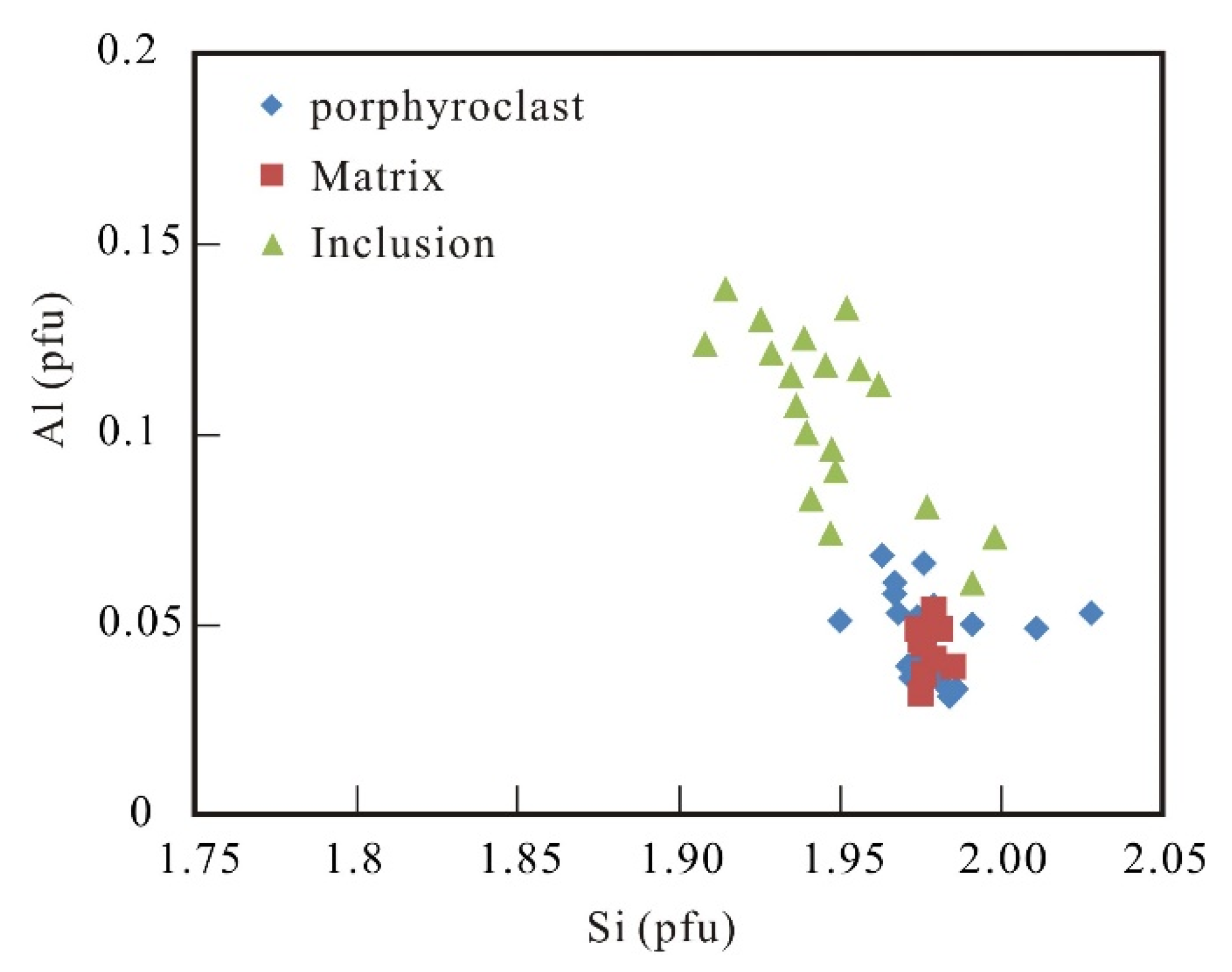

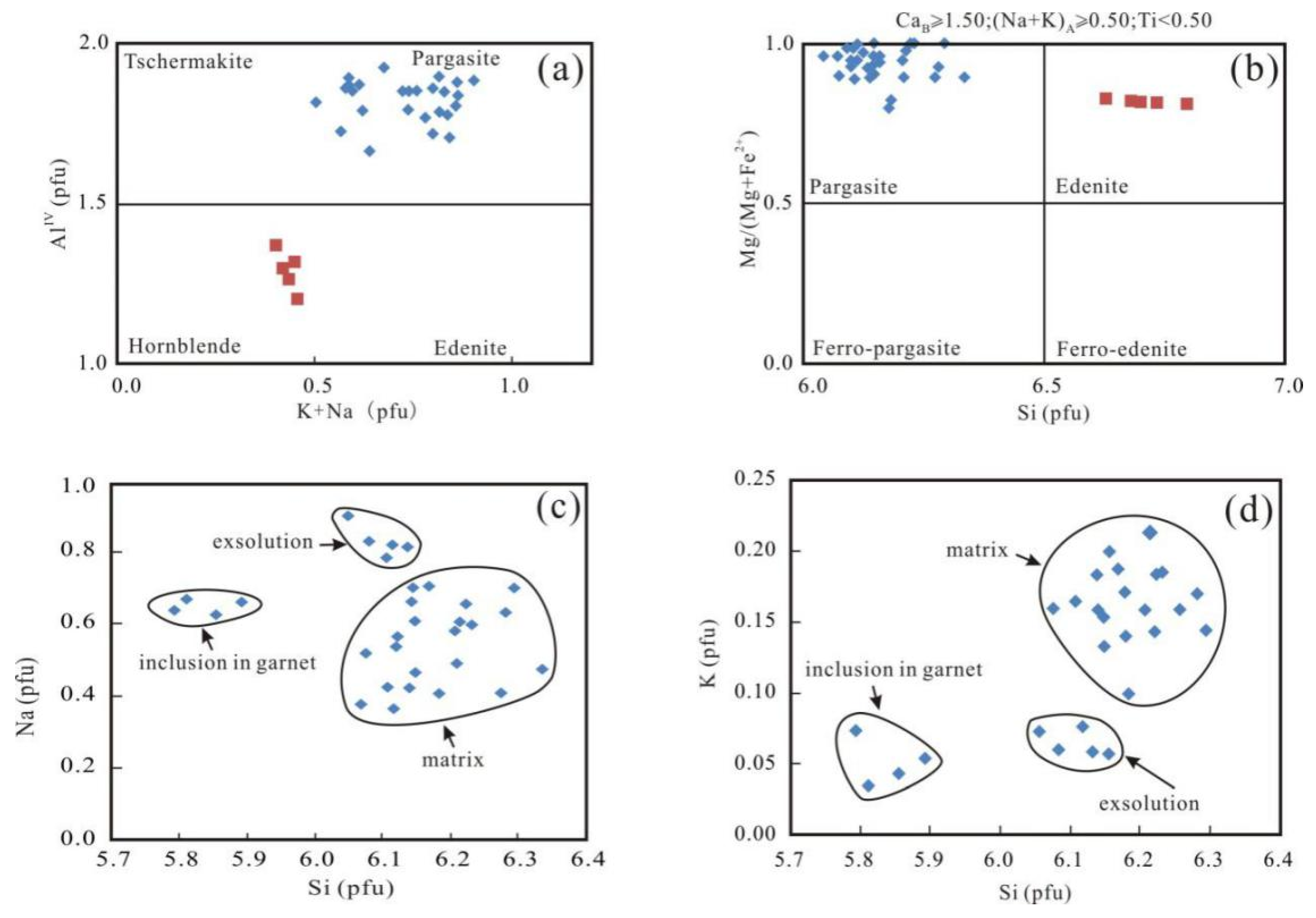


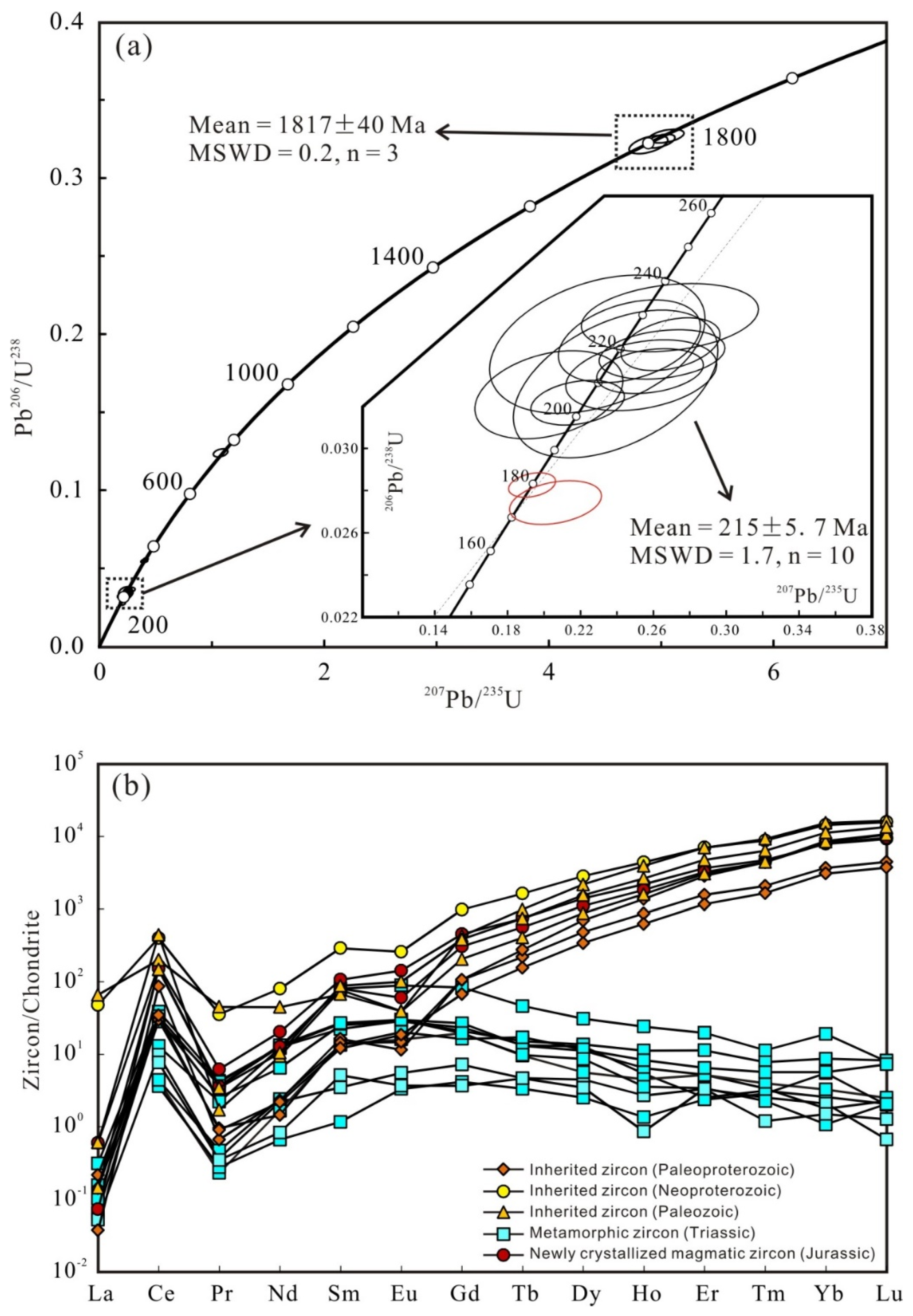
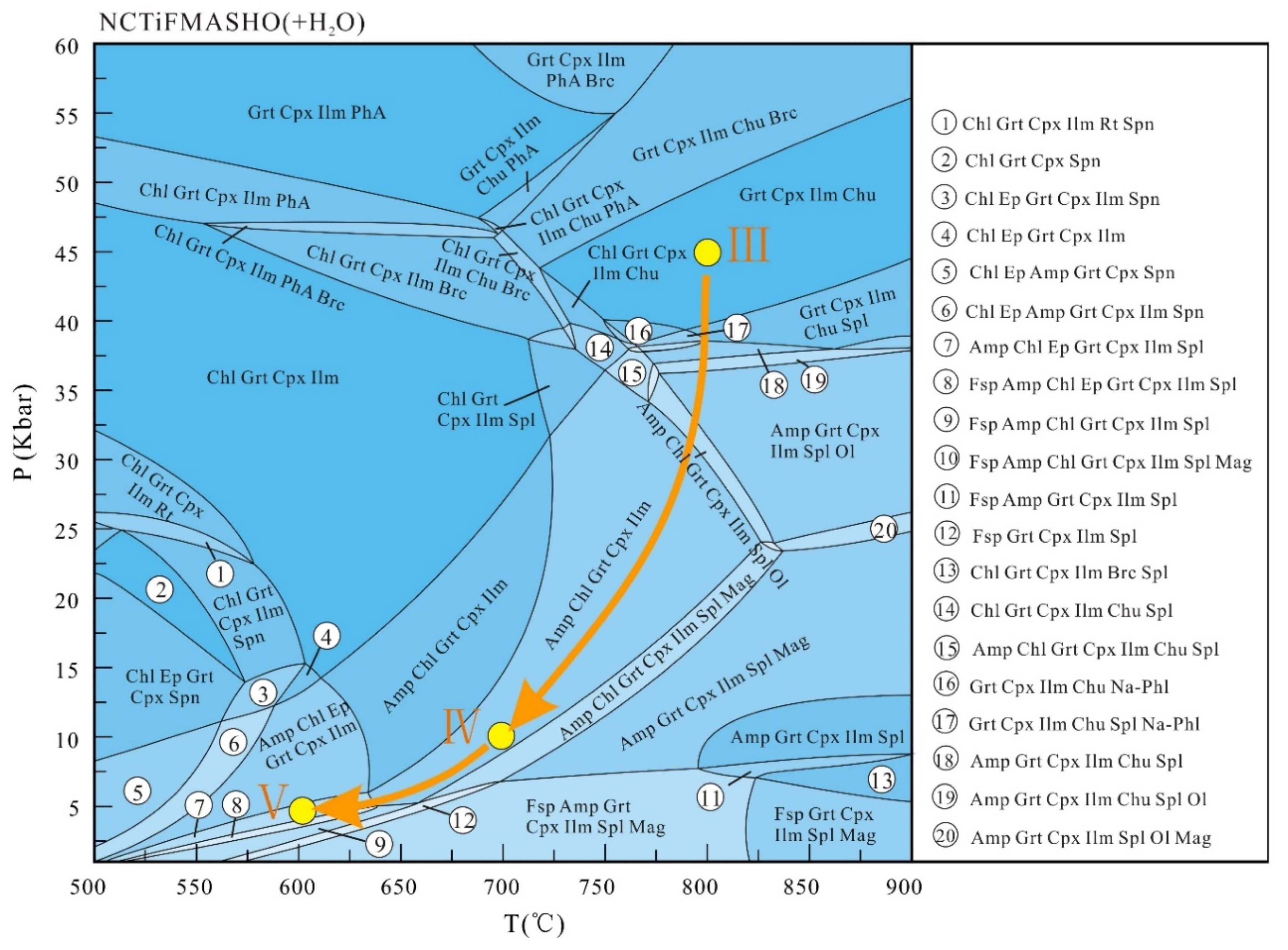
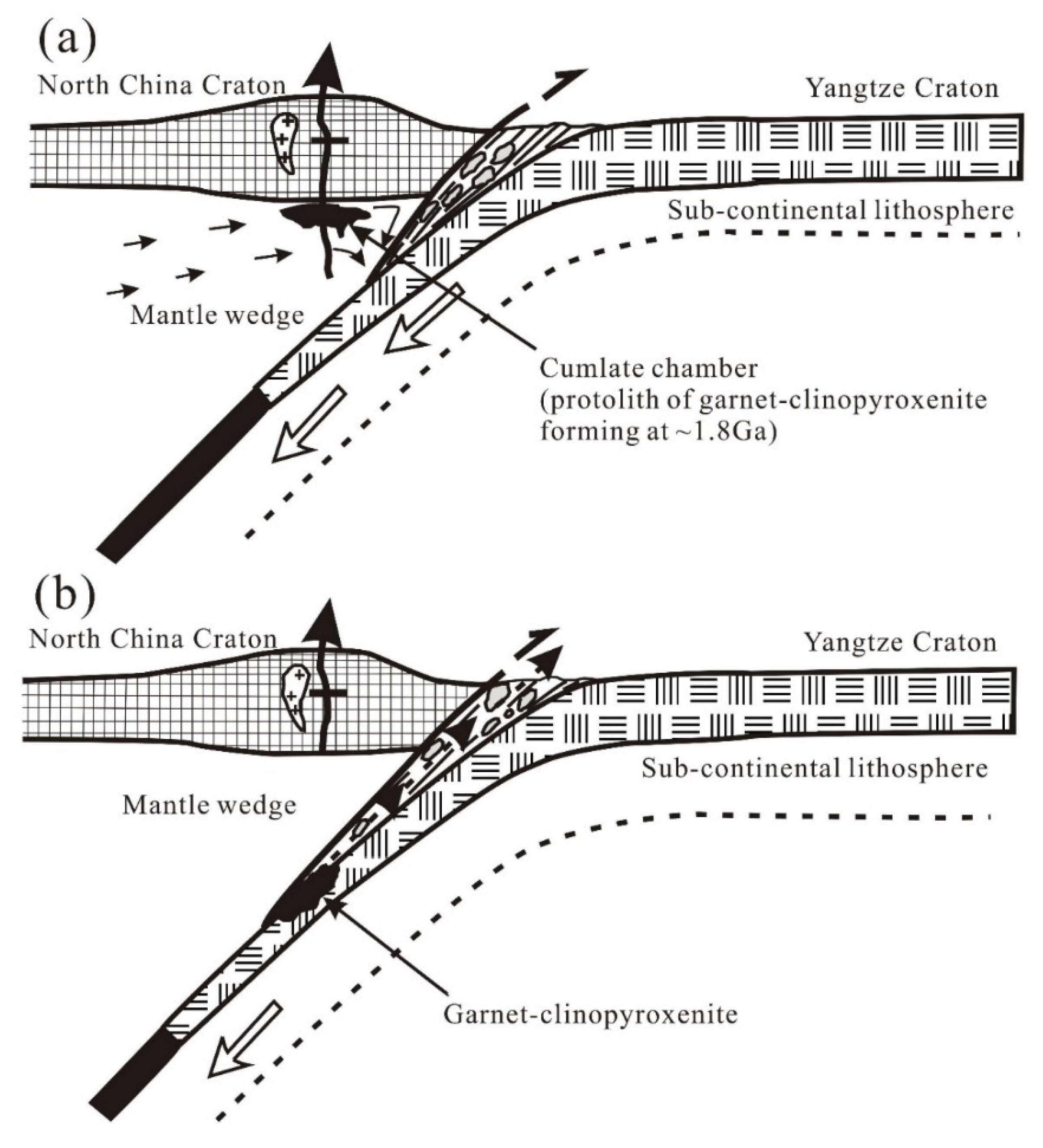
© 2020 by the authors. Licensee MDPI, Basel, Switzerland. This article is an open access article distributed under the terms and conditions of the Creative Commons Attribution (CC BY) license (http://creativecommons.org/licenses/by/4.0/).
Share and Cite
Wang, Z.; Zhang, S.; Li, X.-P.; Wang, S.; Wang, D.; Kong, F.-M.; Liu, J.; Li, Z.; Li, D.; Wang, J.; et al. Metamorphic Evolution of Garnet-Bearing Ultramafic Rocks in the Hujialin Area, Sulu Ultrahigh-Pressure Orogenic Belt, Eastern China. Minerals 2020, 10, 225. https://doi.org/10.3390/min10030225
Wang Z, Zhang S, Li X-P, Wang S, Wang D, Kong F-M, Liu J, Li Z, Li D, Wang J, et al. Metamorphic Evolution of Garnet-Bearing Ultramafic Rocks in the Hujialin Area, Sulu Ultrahigh-Pressure Orogenic Belt, Eastern China. Minerals. 2020; 10(3):225. https://doi.org/10.3390/min10030225
Chicago/Turabian StyleWang, Zeli, Shukai Zhang, Xu-Ping Li, Songjie Wang, Dan Wang, Fan-Mei Kong, Jianguo Liu, Zengsheng Li, Dapeng Li, Jian Wang, and et al. 2020. "Metamorphic Evolution of Garnet-Bearing Ultramafic Rocks in the Hujialin Area, Sulu Ultrahigh-Pressure Orogenic Belt, Eastern China" Minerals 10, no. 3: 225. https://doi.org/10.3390/min10030225
APA StyleWang, Z., Zhang, S., Li, X.-P., Wang, S., Wang, D., Kong, F.-M., Liu, J., Li, Z., Li, D., Wang, J., & Yang, Y. (2020). Metamorphic Evolution of Garnet-Bearing Ultramafic Rocks in the Hujialin Area, Sulu Ultrahigh-Pressure Orogenic Belt, Eastern China. Minerals, 10(3), 225. https://doi.org/10.3390/min10030225




